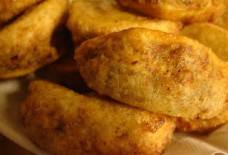Ramadan Breakfast: Harcha--Moroccan Pancakes
As Ramadan is upon us, families are gathering for iftar, the meal served at the end of the day during Ramadan, to break the day’s fast. The word iftar literally means “breakfast” in Arabic. The other meal eaten during Ramadan, which is taken in the morning (pre-dawn), is called suhoor. Suhoor needs to be nutritious to provide enough energy to last during the long fasting hours. Popular foods eaten during suhoor are oatmeal or other breakfast cereals, rice pudding with fruit and milk, yogurt smoothies or date milkshakes to provide dairy and hydration, and eggs for protein.
Harcha, or Moroccan pancakes, are wonderful for breaking the fast as they contain filling yet easy to digest semolina, as well as yogurt for protein. The name Harcha means “rough” in Arabic, because these hotcakes do have a rough texture on the outside. Generally, more semolina is sprinkled on the outside as they are cooked, yielding a rustic and almost crunchy exterior, and a tender and moist interior. Some historians theorize that these pancakes originated from the Berbers during Medieval times, but the popularity of this warm breakfast treat is still strong and alive today.
Generally, street vendors in Morocco sell these pancakes with butter, jam, or honey. Fig jam, grape molasses, melted butter and cinnamon all make great toppings for harcha. Traditionally these pancakes are served for breakfast, especially during Ramadan.
Harcha – Moroccan Semolina Pancakes
- ½ Cup Greek Yogurt
- ½ tsp baking powder
- ½ tsp baking soda
- 4 tbsp melted butter (cooled to room temperature)
- ½ cup milk (any kind, regular or plant milk)
- ½ cup semolina
- ½ cup flour
- ½ tsp cinnamon
Combine the Greek yogurt, baking powder, and baking soda. Let sit for 1 minute to give the agents time to react. The yogurt should be more fluffy. Whisk in the butter and milk. Gently fold in the semolina, flour, and cinnamon. Heat a buttered griddle to 375 degrees, and pour about ⅓ cup for each pancake. Flip over after seeing bubbles to the surface. Serve warm with butter, honey, jam, fruit, or grape molasses.
Blanche Shaheen is the author of the cookbook called “Feast In the Middle East, a Journey of Family and Cuisine” which you can order here: https://secure.mybookorders.com/mbo_index.php?isbn=9781545675113 She is also a journalist, and host of the popular cooking show called Feast in the Middle East. She specializes in Arab cuisine of the Levant and beyond. You can check out her cooking video tutorials at https://www.youtube.com/user/blanchetv Her recipes can also be found at: https://feastinthemiddleeast.wordpress.com/
Check out Arab America’s blog here!








